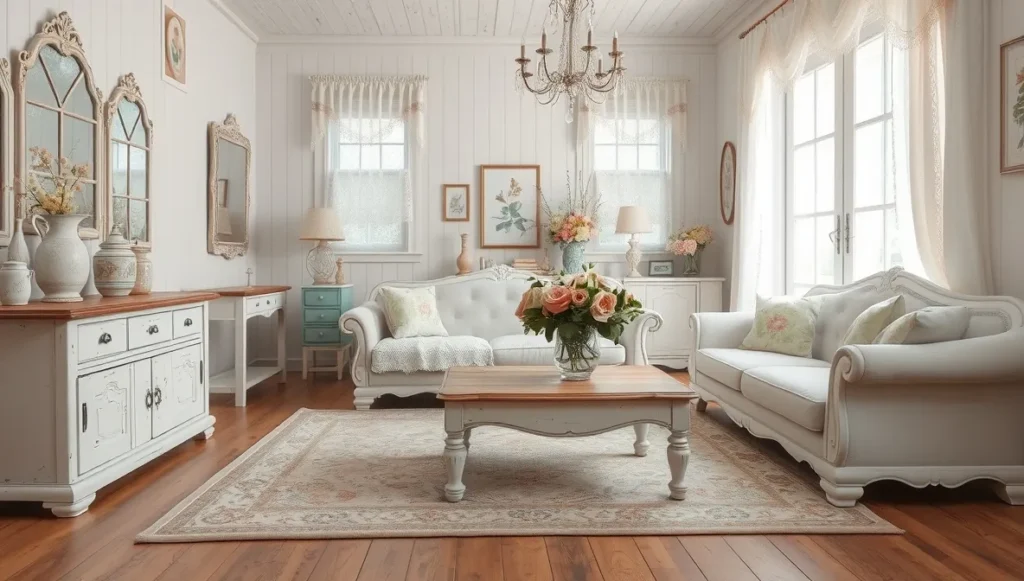- Why Vintage Interior Design Still Has My Heart - September 3, 2025
- Still in Love with Traditional Design – And Here’s Why - September 3, 2025
- The Enduring Charm of English Country Design: Why This Style Never Goes Out of Fashion - September 2, 2025
Table of Contents
Honestly? I fell into shabby chic by accident. 2010, tight budget project, client with a house full of her grandmother’s stuff she wanted to dump. “It’s all old junk,” she kept saying. Took me three hours of digging through boxes to realize we had stumbled onto treasure. That job changed everything for me – and probably saved me from designing another beige living room. Here’s the photo I’m talking about.
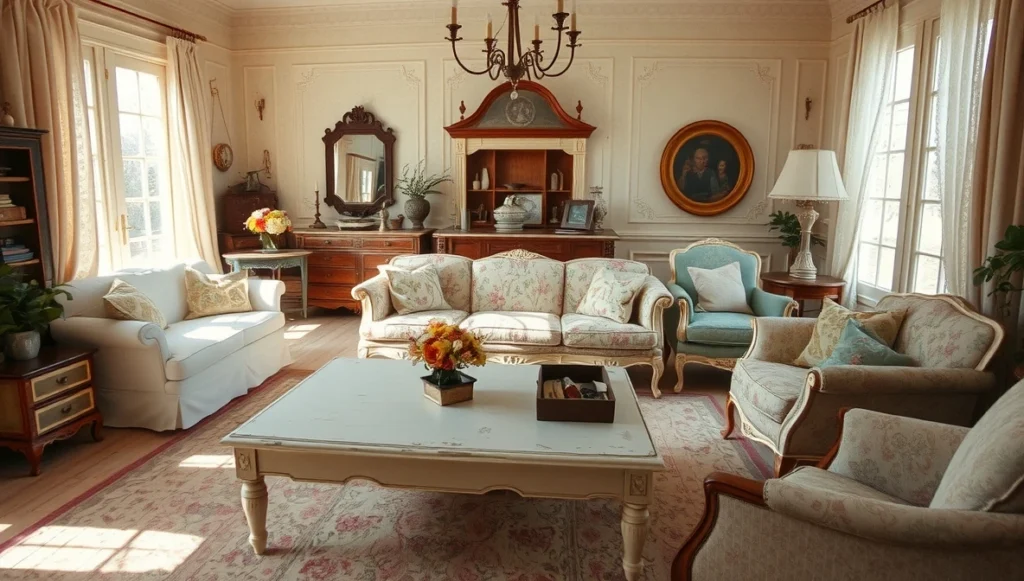
Let’s Talk About What Shabby Chic Actually Is
Look, everyone screws this up. Rachel Ashwell didn’t invent shabby chic to give us permission to beat up furniture with hammers. She saw something beautiful in pieces that had actually lived – real wear patterns, genuine aging, the kind of patina you can’t fake with sandpaper and paint. Had a client once bring me a brand new dresser from Target. Wanted me to make it look “shabby chic.” I tried explaining that you can’t fake 50 years of wear in an afternoon with some sandpaper. She didn’t get it. Hired someone else who distressed the hell out of it. Looked awful.
Think French countryside meets English cottage, with a dose of romantic practicality thrown in. It’s elegant without being stuffy, comfortable without being sloppy. The whole point is celebrating imperfection that comes naturally, not manufacturing it in your garage with power tools.
Colors That Don’t Suck
Pinterest lied to you. Shabby chic isn’t just white and baby pink everywhere. That’s a nursery, not a grown-up room. Real shabby chic colors have depth. Creams with yellow undertones. Whites that lean gray. Blues like faded denim. Greens that remind you of sage that’s been drying in someone’s kitchen for months. I painted a client’s bedroom what looked like tea-stained paper once. Sounds disgusting, right? Photos don’t do it justice – in person, it was magic.
The secret is testing colors in different light throughout the day. What looks perfect at noon might look terrible at 6 PM when you’re actually trying to relax in the room. Shabby chic colors should feel warm and welcoming, not cold or stark.
Finding the Right Pieces (Without Breaking the Bank)
Estate sales are where the magic happens
Show up at 7 AM when they open, or come back Sunday afternoon when sellers are desperate to clear out. I’ve found $2,000 antique wardrobes marked down to $200 because nobody wanted to move them.
Thrift stores? Hit or miss, but when you hit, you really hit. Check the same stores weekly – good stuff moves fast. Facebook Marketplace is insane right now for estate cleanouts. People just want this stuff gone.
The restoration reality
Not everything needs work. Sometimes a good cleaning reveals beautiful patina that you’d never want to paint over. I learned this the hard way when I nearly ruined a gorgeous oak table by assuming it needed paint.
When you do need to distress pieces, less is more. Focus on areas that would naturally wear – edges, handles, around keyholes. I use fine sandpaper and work slowly. You can always remove more; you can’t put it back.
Room Breakdowns (The Real-World Version)
Living Rooms That Actually Work
Start with a sofa that’s actually comfortable enough to nap on. Those spotless white linen sofas you see on Instagram? They don’t survive real life for long. Go for one with removable slipcovers you can toss in the washing machine – that’s the real luxury.
Nothing has to match. In fact, it shouldn’t. Low coffee table, couple of different chairs, maybe something to put your feet up. The goal is looking like pieces found their way to you over time, not like you ordered a living room set from a catalog.
Lighting makes or breaks these spaces. Harsh overhead lights kill the mood instantly. Layer table lamps, maybe a chandelier if your ceiling height works, definitely some candles for evening ambiance.
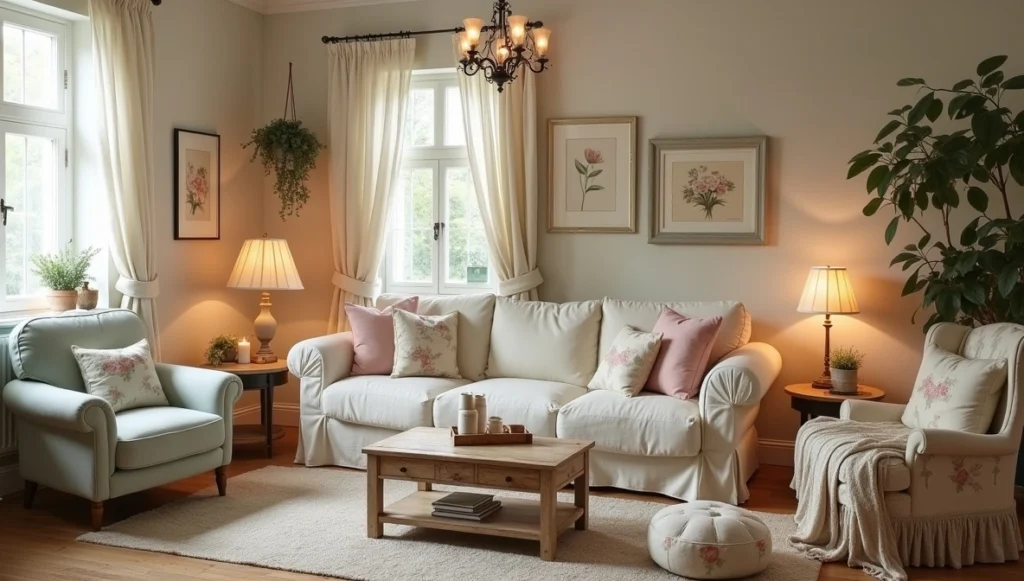
Bedrooms Need to Actually Work for Sleep
Pretty beds that hurt your back are useless. Start with proper support, then worry about how it looks. That fancy vintage frame means nothing if your mattress sags or doesn’t fit right.
Layered bedding looks gorgeous in photos, but you still need to be able to find the sheets at 2 AM. Start simple – good cotton basics, then add the pretty stuff on top.
I’m obsessed with layered bedding, but it has to be functional. Start with quality basics in neutral colors, then add personality through vintage quilts, embroidered pillows, maybe a throw that looks like it has history.
Window treatments matter more here than anywhere else. You need to block light for good sleep, but heavy modern blackout curtains destroy the aesthetic. I layer light-filtering curtains with heavier panels hidden behind for when you need darkness.
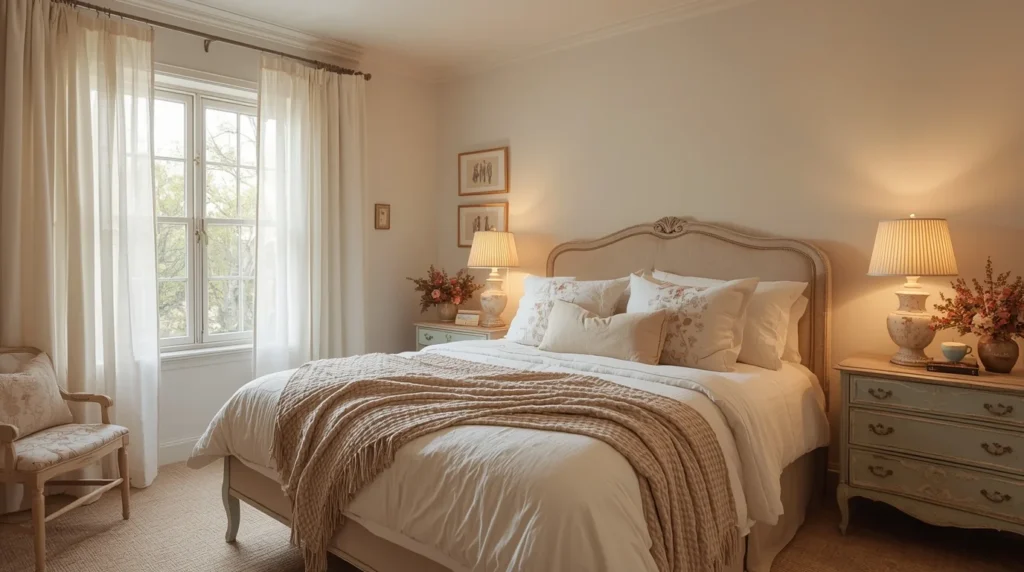
Kitchens Are Tricky Territory
Here’s where people mess up constantly. They get so caught up in making everything look vintage that they forget they actually need to cook in there.
Open shelving for pretty dishes? Sure. But you still need cabinets for your random kitchen gadgets and the ugly stuff nobody wants to see.
Painted cabinets work great if you prep them right. Skip the prep work and your paint will chip off in sheets within six months. Ask me how I know.
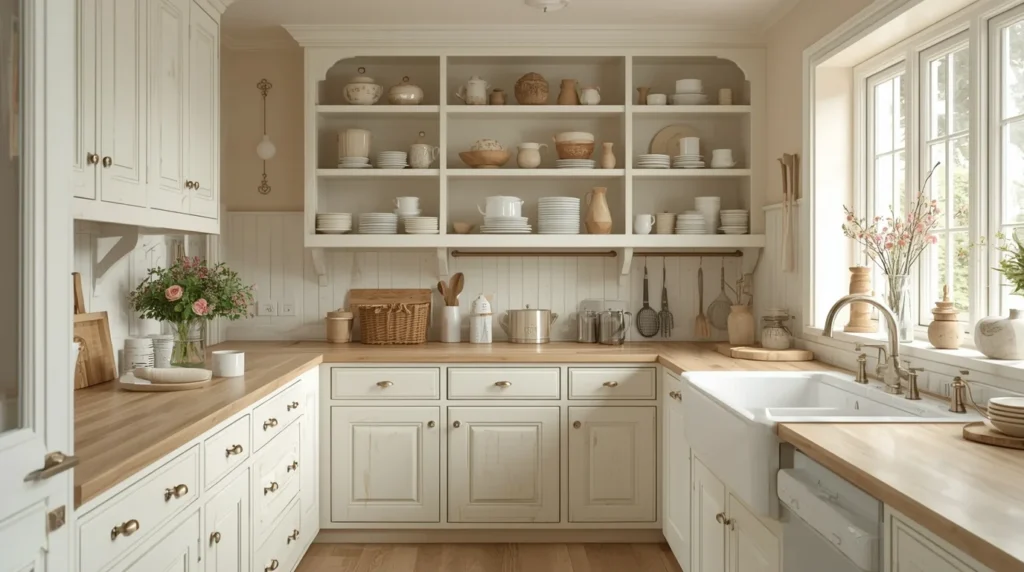
Dining Spaces: Made for Gathering
Center everything around a table that can handle real meals. Distressed is fine, but make sure the surface is smooth enough for actual dining. I’ve refinished table tops while leaving the base weathered – best of both worlds.
Mismatched chairs work if they share something in common – similar heights, complementary colors, or the same general style period. Random chaos doesn’t equal shabby chic.
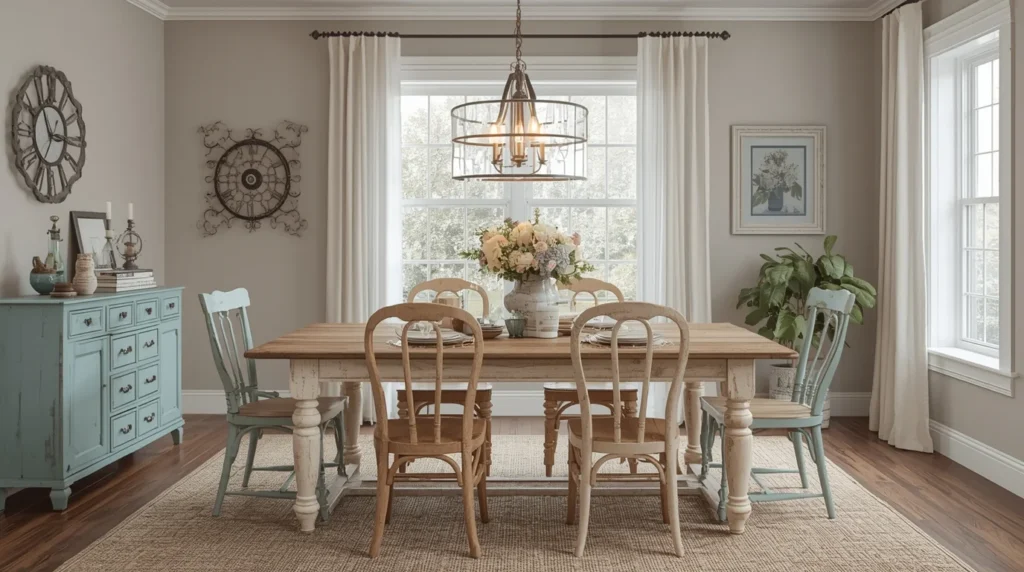
Bathrooms: Soft Sanctuary
Bathrooms are challenging because you need durability in a humid environment. Focus on accessories and textiles rather than permanent fixtures unless you’re doing a full renovation.
Soft towels in natural colors, vintage-style mirrors, maybe some weathered wood storage. Plants that love humidity – like eucalyptus – add life without looking forced.
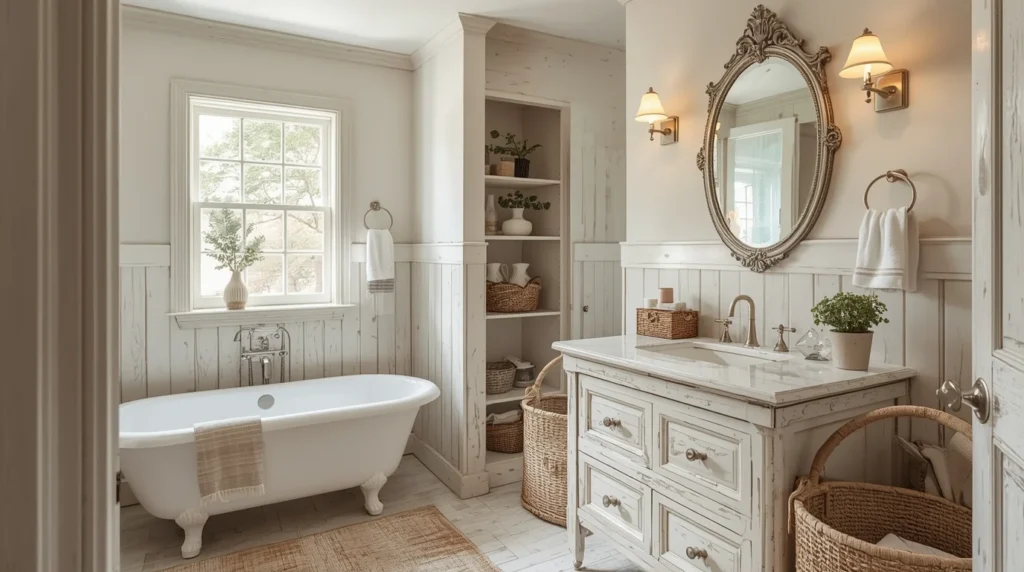
Kids’ Rooms: Beauty Meets Chaos
Children destroy everything beautiful. That’s just science. But you can still do shabby chic in kids’ spaces if you’re smart about it.
Furniture needs to survive marker attacks, juice spills, and whatever mysterious sticky substances kids produce. Painted pieces hide damage better than natural wood finishes.
Storage has to work for small hands. Those beautiful vintage baskets? Useless if a 4-year-old can’t reach them or they fall apart when loaded with Legos.
Oh, and test old paint for lead. Obviously. Beautiful vintage pieces aren’t worth poisoning anyone.
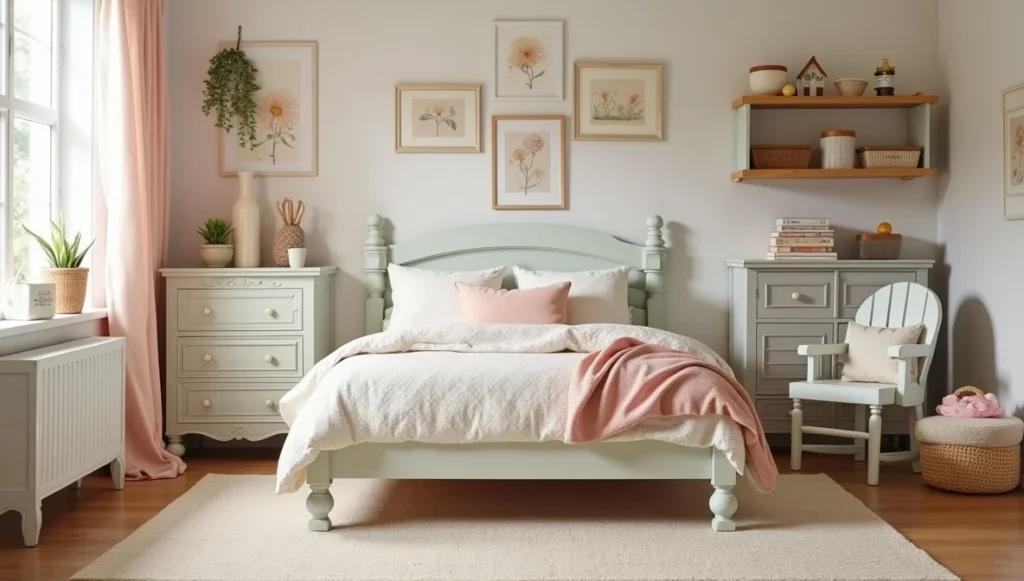
The Mistakes That Scream “Trying Too Hard”
Don’t go crazy with the distressing Every piece doesn’t need to look like it went through a blender. Mix some genuinely old stuff with pieces that just have light wear. Balance is key.
Stop with the pink overload Dusty rose is lovely. A whole room of it makes me want to leave immediately. Use it as an accent, not as wallpaper.
Quit buying every vintage thing you see Just because it’s old doesn’t mean it belongs in your house. I’ve seen people cram so much “vintage character” into rooms that you can’t move without knocking something over.
Forgetting about scale Tiny rooms can’t handle massive armoires. Large spaces get lost with only delicate pieces. Match your furniture scale to your room size.
Working This Into Modern Houses
Can shabby chic work in a sleek contemporary home? Yeah, but you can’t go nuts with it.
Pick one room to really commit to the look. Maybe the master bedroom or a reading nook. Then sprinkle hints elsewhere – some vintage lighting, soft textiles, weathered wood accents.
Don’t try to shabby-chic-ify your entire modern minimalist house. It’ll look like you’re having an identity crisis.
Why People Keep Coming Back to This Look
This style sticks around because it gives us permission to be imperfect. Your couch can have a worn spot where the dog sleeps. Your dining table can have rings from coffee cups. These aren’t flaws anymore – they’re proof that you actually live in your house.
Plus, there’s something satisfying about rescuing furniture that other people gave up on. Every piece has survived something. That matters more than we like to admit.
Shabby chic also fights against our throwaway culture. Instead of buying new when something gets worn, you celebrate the wear. It’s almost rebellious in a world that constantly tells us to upgrade and replace.
What I’ve Learned After 15 Years of This
The best shabby chic rooms don’t look designed. They look like they happened naturally over decades, like pieces just found their way home over time.
Start with one thing you genuinely love. Maybe it’s a mirror you found at a garage sale, or your grandmother’s sewing chair. Build around that. Don’t try to create a whole look from a magazine photo.
And please – make sure you can actually live in the space. The most gorgeous shabby chic room is worthless if you’re afraid to sit on the furniture or put a drink down anywhere.
Your house should tell your story, not someone else’s idea of what shabby chic should look like.
